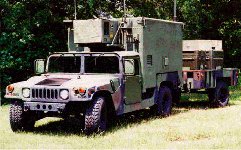


Tactical Airspace Integration System (TAIS)
The Army's Tactical Airspace Integration System (TAIS) will replace the AN/TSC-61B Flight Operations/Coordination System. The TAIS will be a mobile communications and digitized battlefield automated system for airspace management. The TAIS is planned for employment in any theater of operations
and will be the Army system to meet both Army Airspace Command and Control (A2C2) and Air Traffic Services (ATS) requirements. The TAIS will provide the Force XXI battlefield with automated A2C2 planning, enhanced A2C2 execution, improved theater and intra- and inter-Corps/Division ATS support in war and military operations other than war.
Although the Tactical Air Information System was originally designed principally as an airspace management tool, it has shown itself to have characteristics that the introduction and integration of which into the Army Tactical Command and Control System [ATCCS] family could enhance the lethality and survivability of Army aviation while further enabling the commander to influence his battlespace. Many of the targeting challenges and hazardous aspects of aviation operations, both army and other services, can be mitigated by the introduction of TAIS. TAIS coupled with other ATCCS such as AFATDS, FAADC2I and ASAS components could provide unprecedented clarity of the battlefield. Real and near real time battlefield information integrating the battlefield functions of intelligence, fire support, air defense, aviation maneuver and airspace management would almost ensure that aviation assets are properly directed, protected and controlled. TAIS proposes to provide real time airspace information that displays the location and movement of aircraft transitioning the battlespace overlaid by the actual Airspace Control Measures from the Joint Contingency Tactical air control system Automated Planning System (CTAPS). Supporting systems, such as ASAS and AFATDS, would be synchronized to enable and protect aviation by real time battlespace information. Instead of templating, thereby increasing the probability of missing the target. TAIS gives the commander the ability to view their assets moving down the ACM to its target. It allows for real time synchronization of artillery fires and CAS. It also allows for real time synchronization of ADA systems to allow for the tightest coverage for ground units possible without endangering friendly air assets. This system brings a before unimagined lethality and survivability to the attack helicopter.
Airspace management tools employed by the Army systems should be compatible with Air Force systems. The integration of TAIS and CTAPS would derive a joint interoperability further enhancing the lethality and survivability of all services attack aircraft. Army deep operations have been generally restricted to locations between the FLOT and the FSCL. The introduction of TAIS and other supporting ATCCS components enable army aviation to project combat power beyond the FSCL. The ability of fire support to range and target systems must be a consideration but, the ability to conduct JAAT operations will most certainly exceed historical distances. The integration of TAIS and CTAPS can significantly enhance the commander�s ability to shape the battlespace. TAIS for the first time bridges the gap between the Army and the joint CTAPS system allowing commanders a single device to request airspace measures and depict them.
The introduction and integration of an army airspace management tool (TAIS) with existing systems represents a tremendous potential increase in the lethality and survivability to army and sister service aviation forces. Shaping operations and dominant maneuver is significantly enhanced several fold by integration of a system, like TAIS. It enables commanders to affect the enemy at unprecedented distances and accuracy, maximizing the potential out of every long range system on the battlefield.

Sources and Resources
http://www.fas.org/man/dod-101/sys/ac/equip/tais.htm
Maintained by Robert Sherman
Originally created by John Pike
Updated Saturday, January 09, 1999 10:27:01 AM


